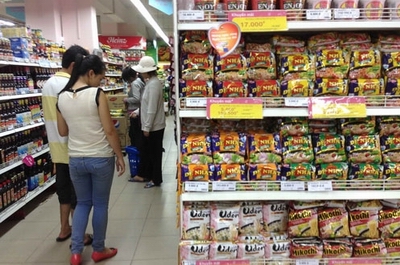
A report of the world’s instant noodle association showed that Vietnam is the fourth biggest instant noodle consumer in the world with 5.1 billion packs consumed in 2012. Every Vietnamese ate 57 packs of instant noodles last year, ranking the third in the world, after South Korea and Indonesia, in terms of the consumption per capita.
In 2009, Vietnam consumed 4.3 billion packs, while the figure jumped to 5.1 billion in 2012 and is expected to increase more sharply in the time to come. In Vietnam, instant noodles are served both at popular street shops and luxury restaurants. Instant noodles are available everywhere, including at Internet agents. The majority of people have the habit of storing noodles in case they need fast food.
A senior executive of Big C, one of the biggest retail distribution chains in Vietnam, said the retailer now distributes instant noodles bearing over 60 different brands, both Vietnamese and foreign (Thai and South Korean). The cheapest product is priced at VND2.900 per pack, while the most expensive VND30,300.
According to Saigon Co-op Mart, domestic products are priced between VND2,500-5,500 per pack, while imports are more expensive, priced at VND5,500-25,000.
The representative of the retail chain has noted that consumers tend to buy the products with competitive prices, good packing designs and the products under sale promotion programs.
The very high demand for instant noodles, both from popular to high income people, has made the industry really attractive to investors.
Kinh Do Group, which has been known as a sweets manufacturer, has announced that it would make instant noodles, vegetable oil and dairy products as well. The report released at the 2013 shareholders’ meeting of the company showed that the group’s instant noodle products would hit the market by June 2013.
Tran Le Nguyen, President and CEO of Kinh Do Group, said since Kinh Do is a new comer, it would not compete directly with big rivals, but would target niche markets.
The southern instant noodle market is worth $2 billion a year, therefore, Nguyen believes that Kinh Do still has the opportunities to develop its instant noodle brand.
The decision by Kinh Do to jump into the instant noodle market does not surprise anyone, who understands the high attractiveness of the market.
In July 2012, Japanese Nissin Foods also joined the Vietnamese market when setting up a $41 million factory in Binh Duong province. The group has 47 factories in 15 countries which generate 1,200 product items for the global market.
In the same year, Vina Acecook increased its investment capital in Vietnam by $10 million and put two factories, the most modern ones in South East Asia, into operation in HCM City.
The manufacturer has confidence on its success in Vietnam with a large network of 700 distributors throughout the country, 7 factories in HCM City, Binh Duong, Vinh Long in the south, Da Nang in the central region, and Bac Ninh, Hung Yen in the north.
Despite the current economic difficulties, the turnover of instant noodle manufacturers has been increasing steadily by 10-30 percent per annum. Acecook reported the 30 percent increase in turnover in 2011. South Korean Nong Shim maintains the 27-35 percent per annum increase in turnover since 2005 for its Shin Ramyun products. The high growth rates explain why more and more new investors appear every year, though there are 50 operational instant noodle manufacturers already.





